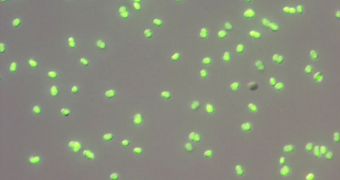Bacteria are widely known for their amazing ability to withstand conditions that could kill an average person over a short period of time. Among these microorganisms, the strongest and toughest is Deinococcus radiodurans. It is able to endure very high temperatures, it can survive scorching drought conditions or the lack of nutrients, and also radiation dosages that exceed the maximum-allowed limit for humans 1,000 times over. Scientists at the Cornwall University have now finally managed to unlock its secrets, PhysOrg reports.
The team has determined that the key to D. radiodurans' resistance, and ability to recover after being exposed to massive doses of ultraviolet radiation, is nitric oxide, one of the compounds that are responsible for the formation of smog over crowded cities. The molecule is also used in a number of metabolic processes in animals, and is invaluable to life. Details of the study were published online, in the October 19 issue of the respected journal Proceedings of the National Academy of Sciences.
CU Associate Professor of Chemistry and Chemical Biology Brian Crane led a team of researchers that discovered for the first time a very peculiar gene inside the bacteria. When exposed to large concentrations of UV radiation, the gene triggers the production of an enzyme that, in turn, is in charge of producing higher concentrations of nitric oxide. “Bacteria are much more sensitive to radiation damage when nitric oxide is not there. If you block the nitric oxide signal, the cell will repair but [will] not divide,” Crane, who is also the senior author of the PNAS paper, adds.
However, the team noticed, the D. radiodurans colonies that were bred to lack the gene did not exhibit any changes in their abilities of handling other stressing factors (stressors), such as oxidation, and exposure to free radicals. “Nitric oxide seems to coordinate this growth response, but it's curious that the bacteria will wait to grow until they have repaired themselves. We don't know why it works this way, but there are analogies in human cells [for other processes]. There may be related pathways for controlling cell growth in animal cells,” Crane concludes.

 14 DAY TRIAL //
14 DAY TRIAL //